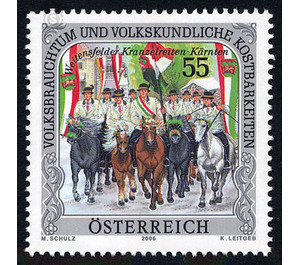folklore - Austria / II. Republic of Austria 2006 - 55 Euro Cent
Theme: Art & Culture
| Country | Austria / II. Republic of Austria |
| Issue Date | 2006 |
| Face Value | 55.00 |
| Edition Issued | 800,000 |
| Printing Type | combination printing |
| Stamp Type | Commemorative |
| Item Type | Stamp |
| Chronological Issue Number | 1927 |
| Chronological Chapter | OOS-OE2 |
| SID | 858672 |
| In 55 Wishlists | |
In ancient times, the area of the market town Weitensfeld in the Gurktal was covered by dense forests and served as a retreat for the Celts. A settlement of major proportions was probably in the 12th century. Weitensfeld is first mentioned in documents in 1131 and received the market right in 1211. 1629 the town was granted a coat of arms. The municipality has the oldest municipal flag of Carinthia, it is over 200 years old. An art historical jewel also originates from the municipality, the "Magdalenenscheibe", Austria's oldest stained glass window, was made around 1170. It is kept in the Landesmuseum Klagenfurt. A legal historical monument represents the "Bürgerid von Weitensfeld", which recorded a market writer in 1765. Every year at Pentecost one of Carinthia's most beautiful customs is cultivated, the Kranzlreiten in Weitensfeld. It is a kind of pledge to commemorate the plague epidemic some 400 years ago. Terribly the "black death" should have raged then. According to legend, only three burgesses have survived, and the damsel of the Castle Thurnhof in Zweinitz. The knightly maiden had called on the young men who stopped for their hand to a race. She handed her hand to the Lebensbund. This resulted in the wreath riding. It must take place every year, otherwise there would be mischief on the market Weitensfeld. Even in the worst years of the war, when there was a great lack of horse and rider, the festival was traditionally held. Today, the Kranzlreiten consists of a race and a race, in which each three boys - members of commercial enterprises of the market town - participate. The festival begins on Pentecost Sunday with an invitation ride to the neighboring villages and a G'stanzlsingen for the inhabitants of the market. On Whitsun the actual competition takes place. The stone maiden in the market fountain is festively decorated, she wears a white dress with a red sash, in her left hand she holds a bunch of keys, in her right a peony. Three times the running distance from the upper market to the virgin's well is ridden by a horsemen galloping, as it were to the expulsion of the plague. Then the three riders start the race, followed by the three runners. The winner of the run is taken on a festive procession to the Jungfrau am Marktbrunnen, receives a wreath, a silk kerchief and a pair of stockings and may kiss the maiden on the well base. Every 25 years, this custom is especially committed: Instead of the stone maiden, a real Mayflower takes the wreath and the kiss of the winner.


